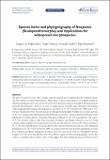| dc.description.abstract | Abstract The genus Newportia Gervais, 1847, includes some 60 nominal species distributed in the Caribbean islands and from Mexico to central South America. Modern keys to species and subspecies are available, greatly facilitating identification, but some species are based on few specimens and have incomplete documentation of taxonomically-informative characters. In order to explore genetic variability and evolutionary relationships within geographically-widespread morphospecies, specimens of Newportia (Newportia) stolli (Pocock, 1896) and Newportia (Newportia) divergens Chamberlin, 1922, two nominal species distinguished principally by differences in suture patterns on T1, were sequenced for mitochondrial 16S rRNA and cytochrome c oxidase subunit I (COI) genes from populations in southern Mexico, Guatemala, Honduras and Brazil. Newportia (Newportia) stolli is paraphyletic with respect to Newportia (Newportia) divergens within a clade from Guatemala, Honduras, and Chiapas (Mexico), most trees being consistent with a single loss of a connection between the anterior transverse suture on T1, whereas specimens of “Newportia (Newportia) stolli” from Brazil are not closely allied to those from the Mesomerican type area. The widespread morphospecies Newportia (Newportia) monticola Pocock, 1890, was sequenced for the same loci from populations in Costa Rica, Colombia and Brazil, finding that specimens from these areas do not unite as a monophyletic group. Samples of Newportia (Newportia) oreina Chamberlin, 1915, from different regions of Mexico form geographic clusters that resolve as each other’s closest relatives. These results suggest that some widespread species of Newportia may be taxa of convenience more so than natural groupings. In several cases geographic proximity fits the phylogeny better than taxonomy, suggesting that non-monophyletic species do not result from use of inappropriate molecular markers. Molecular identification is possible for specimens missing taxonomically informative morphological characters, notably damaged specimens that lack the ultimate leg pair, a protocol that may also apply to other taxonomically difficult genera that are prone to damage (such as Cryptops). | en |


